State Farm Stadium
State Farm Stadium, formerly known as University of Phoenix Stadium, is a multi-purpose stadium in the western United States, located in Glendale, Arizona, west of Phoenix. It is the home of the Arizona Cardinals of the National Football League (NFL) and the annual Fiesta Bowl. State Farm Stadium replaced Tempe's Sun Devil Stadium as the Valley of the Sun's main stadium. The stadium is adjacent to the Gila River Arena, home of the Arizona Coyotes NHL team.
 | |
 Exterior of the stadium, 2006 | |
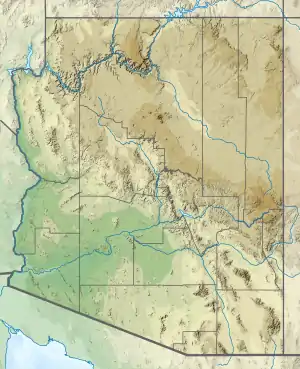 Glendale Location in Arizona  Glendale Location in the United States | |
| Former names | Cardinals Stadium (August–September 2006) University of Phoenix Stadium (2006–2018) |
|---|---|
| Address | 1 Cardinals Drive |
| Location | Glendale, Arizona |
| Coordinates | 33.528°N 112.263°W |
| Parking | 14,000 on-site parking spaces |
| Owner | Arizona Sports and Tourism Authority |
| Operator | SMG[1] |
| Executive suites | 88 |
| Capacity | 63,400 (expandable to 72,200; standing room to 78,600[2][3]) |
| Surface | Natural grass: Tifway 419 Hybrid Bermuda |
| Construction | |
| Broke ground | April 12, 2003 |
| Opened | August 1, 2006 |
| Renovated | 2014, 2017 |
| Construction cost | $455 million[4] ($577 million in 2019 dollars[5]) |
| Architect | Eisenman Architects Populous (then HOK Sport) |
| Structural engineer | TLCP Structural, Inc. (bowl)[6] Walter P Moore[7] and designed by Walter P Moore (roof)[8] |
| Services engineer | M-E Engineers, Inc.[9] |
| General contractor | Hunt Construction Group[10] |
| Tenants | |
| Arizona Cardinals (NFL) (2006–present) Fiesta Bowl (NCAA) (2007–present) | |
The stadium has hosted the Fiesta Bowl, 2007 and 2011 BCS National Championship Games, 2016 College Football Playoff National Championship, Super Bowl XLII in 2008, the Pro Bowl and Super Bowl XLIX in 2015, and will host Super Bowl LVII in 2023. For soccer, it was one of the stadiums for the 2015 CONCACAF Gold Cup also the first semi-final of the 2019 CONCACAF Gold Cup and the Copa América Centenario in 2016. For basketball, it hosted the NCAA Final Four in 2017, which is scheduled to return in 2024.
The University of Phoenix acquired the naming rights in September 2006, shortly after the stadium had opened under the name Cardinals Stadium and retained the rights until September 2018, when the Cardinals and insurance company State Farm reached an agreement on an 18-year commitment to call it State Farm Stadium.[11][12]
Facility information and history
Since moving to Arizona from St. Louis, Missouri in 1988, the Cardinals had played at Sun Devil Stadium on the campus of Arizona State University in Tempe. The Cardinals planned to play there for only a few years, until a new stadium could be built in Phoenix. However, the savings and loan crisis derailed funding for a new stadium during the 1990s. Over time, the Cardinals expressed frustration at being merely tenants in a college football stadium. The lack of having their own stadium denied them additional revenue streams available to other NFL teams. The Cardinals campaigned several times in the years prior to its construction for a new and more modern facility.
The ceremonial groundbreaking for the new stadium in 2003 was held on April 12, and after three years of construction, the 63,400-seat venue opened on August 1, 2006. It was designed by Eisenman Architects and HOK Sport (now Populous).[13] The stadium is considered an architectural icon for the region and was named by Business Week as one of the ten “most impressive” sports facilities on the globe due to the combination of its retractable roof (engineering design by Walter P Moore) and roll-in natural grass field,[14] similar to the GelreDome and the Veltins-Arena.[15]
LED video and ribbon displays from Daktronics in Brookings, South Dakota were installed in 2006 prior to Arizona's first game of the season at the new stadium.[16]
The cost of the project was $455 million, which included $395.4 million for the stadium, $41.7 million for site improvements, and $17.8 million for the land. Contributors to the stadium included the Arizona Sports and Tourism Authority ($302.3 million), the Arizona Cardinals ($143.2 million), and the City of Glendale ($9.5 million).
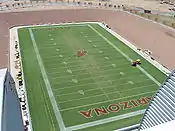

The stadium has 88 luxury suites — called luxury lofts — with space for 16 future suites as the stadium matures.
The 25 acres (10 ha) surrounding the stadium is called Sportsman's Park. Included within the Park is an 8-acre (3.2 ha) landscaped tailgating area called the Great Lawn. The approximate elevation at field level is 1,070 feet (330 m) above sea level.
There are no obstructed view seats in the stadium. There are visible areas in the upper deck of the end zone where seats could have been put in but were not due to the giant super columns supporting the roof structure.
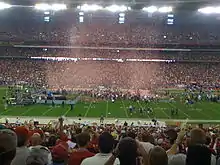
The stadium seating capacity can be expanded by 8,800 for "mega-events" such as college bowls, NFL Super Bowls, the NFC Championship Game, and the Final Four[17] by adding risers and ganged, portable "X-frame" folding seats. The end zone area on the side of the facility where the field tray rolls in and out of the facility can be expanded to accommodate the additional seats.
The roof is made out of translucent Birdair fabric and opens in 12 minutes. It is the first retractable roof ever built on an incline.
Events
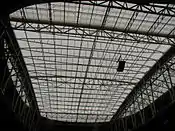
Events held at the stadium include Arizona Cardinals home games; public grand opening tours held August 19 and 20, 2006 (attended by 120,000 people); various shows, expositions, tradeshows and motor sport events; the AIA 4A and 5A state championship games for football; and international soccer exhibition matches.
The multipurpose nature of the facility has allowed it to host 91 events representing 110 event days between the dates of August 4, 2006 through the BCS National Championship January 8, 2007.
NFL
The first preseason football game was played August 12, 2006 when the Cardinals defeated the Pittsburgh Steelers, 21–13. The first regular season game was played September 10 against the San Francisco 49ers (the Cardinals won 34–27). The stadium's air-conditioning system made it possible for the Cardinals to play at home on the opening weekend of the NFL season for the first time since moving to Arizona in 1988.
On October 16, 2006, the stadium hosted a notable game between the Cardinals and the undefeated Chicago Bears where the Bears came back from a 20-point deficit to defeat the Cardinals. The Bears would later go on to play in Super Bowl XLI.
University of Phoenix Stadium hosted Super Bowl XLII on February 3, 2008 in which the New York Giants defeated the previously undefeated New England Patriots 17–14 with a paid attendance crowd of 71,101. This was the second time the Phoenix area hosted a Super Bowl, the other being Super Bowl XXX held in nearby Tempe at Sun Devil Stadium in 1996 when the Dallas Cowboys defeated the Pittsburgh Steelers 27–17.
The Cardinals' first home playoff game since 1947 took place at the stadium on January 3, 2009, with Arizona beating the Atlanta Falcons, 30–24 in overtime. The stadium also hosted the 2008-09 NFC Championship Game between the Cardinals and Philadelphia Eagles on January 18, 2009, which the Cardinals won 32–25 in front of over 70,000 fans in attendance and advanced to Super Bowl XLIII.
The 2015 Pro Bowl was the first Pro Bowl to be held at the same location as the same year's Super Bowl since 2010. The Pro Bowl returned to Hawaii in 2016.[18] On February 1, 2015, the New England Patriots defeated the Seattle Seahawks 28–24 in Super Bowl XLIX held at the stadium.
On November 30, 2020, it was announced that because of Santa Clara County's new COVID-19 rules barring contact sports, the 49ers could not play at their home Levi's Stadium; the 49ers were subsequently forced to play their final three home games against the Buffalo Bills, the Washington Football Team, and the Seattle Seahawks at State Farm Stadium. Including the road game against the Cardinals, the 49ers played four straight games at State Farm Stadium to end the season.

College football
The stadium was the venue for the Fiesta Bowl on January 1, 2007 featuring the Boise State Broncos vs. the University of Oklahoma Sooners (Boise State won 43–42 in overtime); and the BCS National Championship on January 8, 2007 between the (1) Ohio State Buckeyes and the (2) University of Florida Gators, which the Gators won 41–14.
It also hosted the 2008 Fiesta Bowl between the Oklahoma Sooners and the West Virginia University Mountaineers, as well as the 2009 Fiesta Bowl between the Texas Longhorns and the Ohio State Buckeyes. It has also held many high school graduations.
On January 10, 2011, the 2011 BCS National Championship Game between the Auburn Tigers and the Oregon Ducks had an attendance record setting 78,603 on hand for the game.
On January 11, 2016, University of Phoenix Stadium hosted the College Football Playoff National Championship Game featuring No. 2 ranked Alabama Crimson Tide and No. 1 ranked Clemson Tigers.
College basketball

Before 2018, the venue was known as University of Phoenix Stadium. It hosted the Final Four, the semifinals and championship game of the NCAA Division I Men's Basketball Tournament, in 2017, and will do so again in 2024.
Soccer
On February 7, 2007, the stadium hosted a soccer match attended by 62,462 fans. The United States men's national soccer team defeated Mexico, 2–0. On January 21, 2012, the U.S. played against Venezuela and won the match 1–0.
On January 30, 2013, Mexico played against Denmark, a game that was broadcast on Televisa Deportes, UniMás, and TV Azteca. The match ended in a 1–1 draw.[19]
On November 19, 2015, the stadium was one of the sites selected for the 2016 Copa América Centenario.[20][21][22] The stadium hosted three matches, including Mexico vs. Uruguay on June 5, and the third-place match (United States vs. Colombia) on June 25.
In club soccer, Real Madrid battled MLS side LA Galaxy in August 2013. The Spanish side defeated the Galaxy 3–1.
The stadium has hosted the CONCACAF Gold Cup and the first semi-final of the 2019 Gold Cup.
| Date | Winning Team | Result | Losing Team | Tournament | Spectators |
|---|---|---|---|---|---|
| February 7, 2007 | 2–0 | International Friendly | 62,462 | ||
| July 12, 2009 | 4–0 | 2009 CONCACAF Gold Cup Group C | 23,876 | ||
| 2–0 | |||||
| November 19, 2011 | 1–1 | Women’s International Friendly | 18,482 | ||
| January 21, 2012 | 1–0 | International Friendly | 22,403 | ||
| December 1, 2012 | 2–0 | Women’s International Friendly | 11,570 | ||
| January 30, 2013 | 1–1 | International Friendly | 43,345 | ||
| August 1, 2013 | 3–1 | 2013 International Champions Cup Round 1 | 38,922 | ||
| April 2, 2014 | 2–2 | International Friendly | 59,066 | ||
| July 12, 2015 | 0–0 | 2015 CONCACAF Gold Cup Group C | 62,910 | ||
| 2–0 | |||||
| December 13, 2015 | 2–0 | Women’s International Friendly | 19,066 | ||
| June 5, 2016 | 3–1 | Copa América Centenario Group C | 60,025 | ||
| June 8, 2016 | 2–2 | Copa América Centenario Group B | 11,937 | ||
| June 25, 2016 | 1–0 | Copa América Centenario Third place game | 29,041 | ||
| July 20, 2017 | 2–1 | 2017 CONCACAF Gold Cup Quarterfinals | 37,404 | ||
| 1–0 | |||||
| January 27, 2019 | 3–0 | International Friendly | 9,040 | ||
| July 2, 2019 | 1–0 | 2019 CONCACAF Gold Cup Semifinal | 62,363 |
WrestleMania
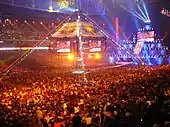
The stadium hosted the WWE event WrestleMania XXVI which took place on March 28, 2010, with 72,219 fans in attendance.[23] This was the first WrestleMania since WrestleMania XI with a non-title match as a main event, the first WrestleMania to be held in the state of Arizona and the third to be held in an open-air venue,[23][24] after WrestleMania IX and WrestleMania XXIV. The event grossed $5.8 million in ticket sales, making the event the highest grossing and attended entertainment event held at the University of Phoenix Stadium.[25]
Concerts
| Date | Artist | Opening act(s) | Tour / Concert name | Attendance | Revenue | Notes |
|---|---|---|---|---|---|---|
| September 8, 2006 | The Black Eyed Peas | — | Monkey Business Tour | — | — | |
| November 8, 2006 | Rolling Stones | Alice Cooper | A Bigger Bang Tour | 41,772 / 41,772 | $3,286,121 | |
| November 26, 2007 | Fall Out Boy | Gym Class Heroes Plain White T's Cute Is What We Aim For Doug | Young Wild Things Tour | N/A | N/A | |
| May 31, 2008 | Kenny Chesney | Keith Urban Gary Allan Sammy Hagar | Poets and Pirates Tour | 40,098 / 47,132 | $3,151,970 | |
| October 20, 2009 | U2 | The Black Eyed Peas | U2 360° Tour | 50,775 / 50,775 | $4,912,050 | |
| September 16, 2014 | One Direction | 5 Seconds of Summer | Where We Are Tour | 56,524 / 56,524 | $5,035,880 | |
| August 15, 2016 | Guns N' Roses | Zakk Wylde Tyler Bryant & The Shakedown | Not in This Lifetime... Tour | 44,110 / 48,914 | $4,257,189 | [26] |
| August 4, 2017 | Metallica | Avenged Sevenfold Gojira | WorldWired Tour | 52,926 / 52,926 | $5,246,586 | |
| September 19, 2017 | U2 | Beck | The Joshua Tree Tour 2017 | 42,814 / 42,814 | $4,169,215 | [27] |
| May 8, 2018 | Taylor Swift | Camila Cabello Charli XCX | Reputation Stadium Tour | 59,157 / 59,157 | $7,214,478 | Before the tour began, Swift invited 2,000 foster and adopted children to a private dress rehearsal.[28] |
| September 19, 2018 | Beyoncé Jay Z | Chloe X Halle and DJ Khaled | On the Run II Tour | 37,174 / 37,174 | $4,426,568 | |
| March 23, 2019 | Garth Brooks | Easton Corbin | The Garth Brooks Stadium Tour | 77,653 / 77,653 | N/A | This is the highest attended indoor concert in Arizona history. |
| August 26, 2019 | The Rolling Stones | Kaleo | No Filter Tour | 52,726 / 52,726 | $9,747,170 | This concert was originally scheduled to take place on May 7, 2019 but was postponed due to Mick Jagger recovering from a heart procedure.[29] This is the highest-grossing concert in the stadium to date. |
Other events
Other events included the Fiesta Bowl National Band Championship High School Marching Band competition. It has also held many high school graduations.
On August 1, 2009, the stadium hosted Monster Jam Summer Heat, with Maximum Destruction defeating Captain's Curse in the racing finals and Grave Digger winning the freestyle event.
The stadium hosted the inaugural Stadium Super Trucks race on April 6, 2013.[30]
On January 30, 2016, Monster Jam returned to the stadium for the first time since 2009, with 16 of the best trucks. On February 6, the AMA Supercross Championship raced for the first time, after visiting Chase Field from 1999 to 2015.
On February 10, 2019 Russell M. Nelson, President of The Church of Jesus Christ of Latter-day Saints, spoke to an audience of 68,000, a larger capacity than many events due to the majority of the field space being filled with seats.
Naming rights
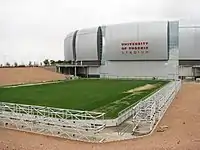
On September 26, 2006 the University of Phoenix acquired the naming rights to the stadium totalling $154.5 million over 20 years.[31] On April 11, 2017, the University of Phoenix terminated the naming rights just 11 years into the 20-year deal, citing financial woes; however, the university kept its name on the stadium until a replacement company was found. On September 4, 2018, State Farm reached a deal securing the rights through 2036. University of Phoenix will remain involved as a sponsor with the team in a reduced capacity as the Cardinals' "official education partner."
Parking space
The stadium has approximately 14,000 on-site parking spaces (plus 12,000 adjacent spaces),[32] located in numerous lots that surround the stadium's 2,000 disabled parking spaces. The design improvement, featured for example in a Discovery program about this stadium, is zoning. Parking spaces for guests are zoned with preferred leaving directions, to achieve the fastest possible movement of traffic.[33]
References
- "SMG Selected to Manage, Operate, Maintain and Market the University of Phoenix Stadium". Archived from the original on 2017-06-05. Retrieved 2017-06-02.
- "The Big Game On the Horizon". Buccaneers.com. February 9, 2008. Retrieved February 13, 2008.
- Auburn Claims SEC's Fifth Straight National Title By Dropping Oregon On Late Field Goal
- University of Phoenix Stadium Archived 2010-02-10 at the Wayback Machine Funding & Economic Impact
- Federal Reserve Bank of Minneapolis. "Consumer Price Index (estimate) 1800–". Retrieved January 1, 2020.
- "The University of Phoenix Stadium Sets New Standards". STRUCTURE magazine. February 1, 2008. Archived from the original on May 26, 2012. Retrieved May 12, 2012.
- Emporis.com - University of Phoenix Stadium
- Gannon, Todd (2008). Eisenman Architects/University of Phoenix Stadium for the Arizona Cardinals. New York: Princeton Architectural Press. p. 100.
- M-E Engineers, Inc. - Projects Archived 2012-05-23 at the Wayback Machine
- This Week's News: The Cardinals Signature Stadium
- Urban, Darren (September 4, 2018). "New Name For Cardinals' Nest: State Farm Stadium". AZCardinals.com. NFL Enterprises, LLC. Retrieved September 26, 2018.
- "Cardinals Reach Naming Rights Agreement with State Farm; Iconic Arizona Venue to be Known as State Farm Stadium". Newsroom.StateFarm.com (Press release). State Farm Mutual Automobile Insurance Company. September 4, 2018. Retrieved September 26, 2018.
- Stadium Statistics Archived 2012-06-11 at the Wayback Machine
- "www.lloydengineers.com".
- World-Class Sports Stadiums: BusinessWeek
- "Installation Spotlight: University of Phoenix Stadium, Glendale, Ariz". Archived from the original on 2010-02-03.
- Watters, Carrie (January 11, 2009). "Cards vs. Eagles Sells Out in 6 Minutes". The Arizona Republic. Retrieved January 12, 2009.
- "2015 Pro Bowl to be played in Arizona - NFL.com". Retrieved April 9, 2014.
- http://www.azcentral.com/sports/azetc/ar
- "Ten Metropolitan Areas from Across the United States Selected to Host Copa America Centenario". CONCACAF.com. 19 November 2015.
- "Diez áreas metropolitanas de Estados Unidos han sido seleccionadas para la organización de la Copa América Centenario". CONMEBOL.com. 19 November 2015.
- "Ten Metropolitan Areas from Across the United States Selected to Host Copa America Centenario". US Soccer. 19 November 2015.
- "Arizona Hosts WrestleMania XXVI". World Wrestling Entertainment. February 24, 2009. Archived from the original on February 27, 2009. Retrieved February 24, 2009.
- "WWE Magazine Feature of the Week". World Wrestling Entertainment. February 13, 2010. Retrieved February 13, 2010.
- "WrestleMania XXVI Breaks Record". World Wrestling Entertainment. March 28, 2010. Archived from the original on April 3, 2010. Retrieved March 29, 2010.
- Young, Alex. "Wolfmother, Zakk Wylde to open Guns N' Roses' reunion tour". Consequence of Sound. Retrieved March 15, 2017.
- Woodbury, Jason P. (19 June 2017). "U2 Will Bring Joshua Tree Tour to Phoenix". Phoenix New Times. Retrieved 19 June 2017.
- Nesvig, Kara (May 7, 2018). "Taylor Swift Invited 2,000 Foster Children to a Private "Reputation" Show". Teen Vogue. Archived from the original on March 5, 2019. Retrieved March 5, 2019.
- Kaufman, Gil (16 May 2019). "Rolling Stones Announce Rescheduled North American Tour Dates". Billboard. Retrieved 3 July 2019.
- "Schedule". Stadium Super Trucks. Archived from the original on October 19, 2013. Retrieved October 18, 2013.
- Wong, Scott (September 26, 2006). "Stadium Name Deal: $154.5 mil Over 20 Years". The Arizona Republic. Retrieved September 26, 2006.
- Statistics - University of Phoenix Stadium Archived 2013-06-22 at the Wayback Machine
- Parking & Directions - University of Phoenix Stadium Archived 2013-06-22 at the Wayback Machine
External links
| Wikimedia Commons has media related to University of Phoenix Stadium. |
